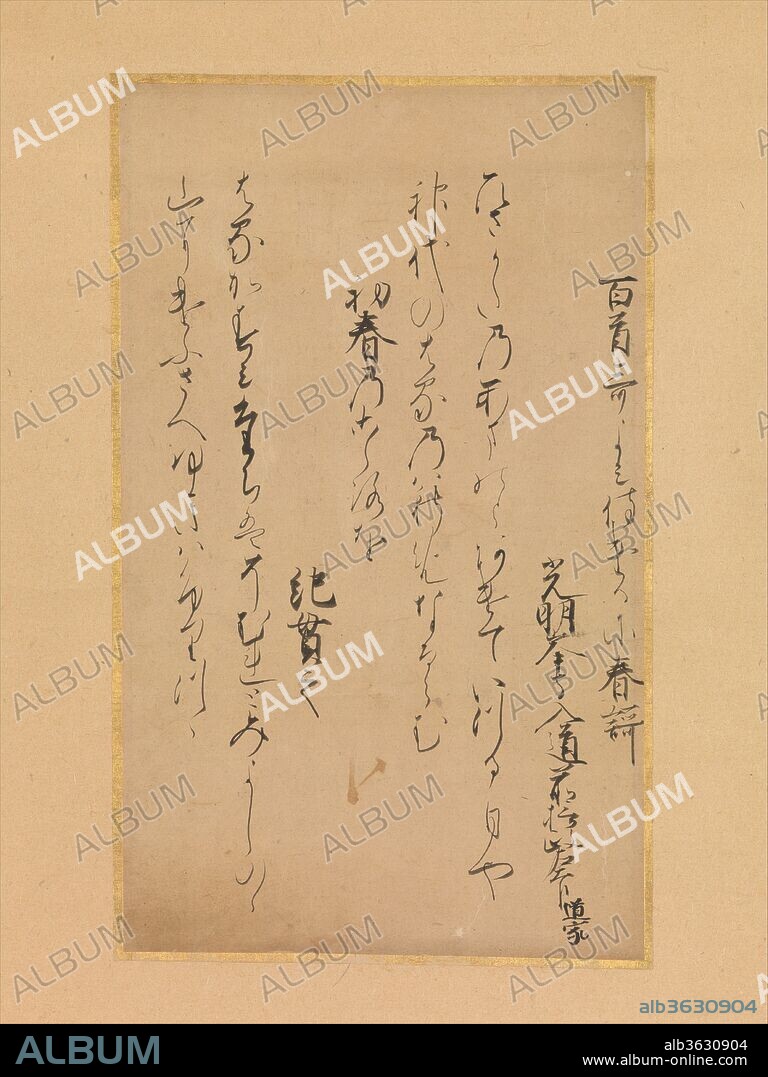alb3630904
TRADITIONALLY ATTRIBUTED TO NUN ABUTSU. Two Poems from the Collection of Poems Ancient and Modern, Continued (Zoku Shoku kokin wakashu)

|
Zu einem anderen Lightbox hinzufügen |
|
Zu einem anderen Lightbox hinzufügen |



Haben Sie bereits ein Konto? Anmelden
Sie haben kein Konto? Registrieren
Dieses Bild kaufen.
Nutzung auswählen:

Titel:
Two Poems from the Collection of Poems Ancient and Modern, Continued (Zoku Shoku kokin wakashu)
Untertitel:
Siehe automatische Übersetzung
Two Poems from the Collection of Poems Ancient and Modern, Continued (Zoku Shoku kokin wakashu). Artist: Traditionally attributed to Nun Abutsu (Japanese, died 1283). Culture: Japan. Dimensions: Image: 9 1/4 × 5 1/2 in. (23.5 × 14 cm)
Overall with mounting: 54 5/16 × 11 in. (138 × 27.9 cm)
Overall with knobs: 54 5/16 × 13 1/2 in. (138 × 34.3 cm). Date: 13th century.
Nun Abutsu (Abutsu-ni), one of the most celebrated woman writers of the age, earned literary fame for her moving account of palace and temple culture in her Diary of the Waning Moon (Izayoi nikki). Before taking Buddhist vows, she served as a lady-in-waiting in the palace and belonged to a circle of talented women writers.
While there is no way to verify that this crisp but elegant calligraphy is in her hand, the style is characteristic of kana calligraphy of the era and the elite society in which she lived. Kana calligraphy (used to inscribe Japanese phonetic characters) was referred to as onna-de, or the "women's hand," since ladies of the court wrote letters, diaries, and prose in the vernacular, while men continued to write primarily in Chinese.
Technik/Material:
Page from a book; ink on paper
Zeitraum:
Kamakura period (1185-1333)
Museum:
Metropolitan Museum of Art, New York, USA
Bildnachweis:
Album / Metropolitan Museum of Art, NY
Freigaben (Releases):
Model: Nein - Eigentum: Nein
Rechtefragen?
Rechtefragen?
Bildgröße:
3202 x 4268 px | 39.1 MB
Druckgröße:
27.1 x 36.1 cm | 10.7 x 14.2 in (300 dpi)
Schlüsselwörter:
 Pinterest
Pinterest Twitter
Twitter Facebook
Facebook Link kopieren
Link kopieren Email
Email
